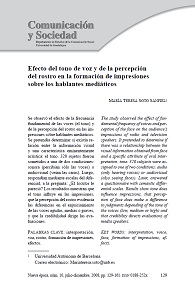Efecto del tono de voz y de la percepción del rostro en la formación de impresiones sobre los hablantes mediáticos
DOI:
https://doi.org/10.32870/cys.v0i10.1846Palabras clave:
interpretación, voz, rostro, formación de impresiones, efectosResumen
Se observó el efecto de la frecuencia fundamental de las voces (el tono) y de la percepción del rostro en las impresiones sobre hablantes mediáticos. Se pretendía determinar si existía relación entre la información visual y una característica eminentemente acústica: el tono. 320 sujetos fueron sometidos a una de dos condiciones: sonora (percibían sólo las voces) o audiovisual (veían las caras). Luego, respondían mediante escalas del diferencial, a la pregunta: ¿El locutor le pareció? Los resultados muestran que el tono influye en las impresiones, que la percepción del rostro evidencia las diferencias en el enjuiciamiento de las voces agudas, medias o graves, y que la credibilidad dirige las evaluaciones.Descargas
Citas
Abele, Andrea E., Petzold, Peter (1998) "Pragmatic use of categorical information in impression formation",Journal of Personality and Social Psychology, vol. LXXV, núm. 2.
Ambady, Nailini, Bernieri, Frank J., Richeson, Jennifer A. (2000) "Toward a histology of social behaviour: judgemental accuracy from think slices of the behavioural stream", Advances in Experimental Social Psychology,vol. XXXII.
Apple, William, Streeter, Lynn A., Krauss, Robert M. (1979) "Effects of pitch and speech rate on personal attributions", Journal of Personality and Social Psychology, vol. XXXVII, núm. 5.
Barge, J. Kevin, Schlueter, David W., Pritchard, Alex (1989) "The effects of nonverbal communication and gender on impression formation in opening statements", Southern Communication Journal, vol. LIV, summer.
Berlo, David K., Lemert, James B., Mertz, Robert J. (1970) "Dimensions for evaluating the acceptability of message sources", Public Opinion Quarterly, vol. XXXIII, núm. 4.
Bond, Ronald N., Welkowitz, Joan., Goldschmid, Harlene, Wattenberg, Sarah (1987) "Vocal frequency and person perception: effects of perceptual salience and nonverbal sensitivity", Journal of Psycholinguistic Research, vol. XVII, núm. 4.
Burgoon, Judee K., Birk, Thomas, Pfau, Michael, (1990) "Nonverbal behaviors, persuasion, and credibility",Human Communication Research, vol. XVII, núm. 1.
Burgoon, Judee K. (1978) "Attributes of the newscaster's voice as predictors of his credibility", Journalism Quarterly,summer.
Caruso, Anthony, Mueller, Peter B., Shadden, Barbara B., (1995) "Effects of aging on speech and voice",Pathology and Audiology, vol. XVIII, núm. 2.
Collins, Sarah A., (2000) "Men's voices and women's choices", Animal Behaviour, vol. LX, núm. 6.
Collins Tidwell, Lisa, Walther, Joseph B., (2002) "Computer–mediated communication effects on disclousure, impressions, and interpersonal evaluations: getting to know one another a bit a a time", Human Communication Research, vol XXVIII, núm. 3.
Daft, Richard L., Lengel, Robert H., (1984) "Information richness: A new approach to managerial behaviour and organizational design", Research in Organizational Behaviour, vol. VI.
Daly, Nicola., Bench, John, (1996) "Interpersonal impressions, gender stereotypes an visual speech", Journal of Language and Social Psychology, vol. XV, núm. 4.
De Paulo, Bella M., Friedman, Howard S. (1998) "Nonverbal communication", en Daniel T. Gilbert, Susan T. Fiske y Gardner Lindzey (eds.), The handbook of social psychology (4th ed., vol. II), New York: McGraw Hill.
Dunning, David, Griffin, Dale W., Ross, Lee, Milojkovic, James D., (1990) "The overconfidence effect in social prediction", Journal of Personality and Social Psychology, vol. LVIII, núm. 4.
Erickson, Bonnie, Lind, E. Allan, Johnson, Bruce C., (1978) "Speech style and impression formation in a court setting: the effects of 'powerful' and 'powerless' speech", Journal of Experimental Social Psychology, vol. XIV, núm. 3.
Fairbanks, Grant, (1940) "Recent experimental investigations of vocal pitch in speech", Journal of the Acoustical Society of America, vol. XI.
Fairbanks, Grant, Pronovost, Wilbert (1939) "An experimental study of the pitch characteristics of the voice during the expression of emotion", Speech Monographs, vol. VI, núm. 1.
Fiske, Susan T., Neuberg, Steven L. (1990) "A continuum of impression formation, from category–based to individuating processes: Influences of information and motivation on attention and interpretation". Advances in Experimental Social Pyschology, vol. XXIII.
Fiske, Susan T., Taylor, Shelley.E. (1991) Social cognition, New York: McGraw–Hill.
Higgins, E. Tory, Rholes, William S., Jones, Carl R. (1977) "Category accessibility and impression formation",Journal of Experimental Social Psychology, vol. XIII, núm. 2.
Jacobson, David, (1999) "Impression formation in cyberspace: online expectations and offline experiences in text–based virtual communities", Journal of Computer Mediated Communication, vol. V, núm. 1,http://jcmc.indiana.edu/vol5/issue1/jacobson.html (último acceso el 28 de agosto de 2007).
Lay, Clarry H., Burron, Bryan F. (1968) "Perception of the personality of the hesitant speaker", Perceptual and Motor Skills, vol. XXVII, núm. 3.
Laukka, Petri, Juslin, Patrik, Bresin, Roberto (2005) "A dimensional approach to vocal expression of emotion",Cognition and Emotion, vol. XIX, núm. 5.
MacDonald, John, Mcgurk, Harry (1978) "Visual influences on speech perception processes", Percepction and Psychophysics, vol. XXIV, núm. 3.
Markham, David, (1968) "The dimensions of source credibility of television newscasters", Journal of Communication, vol. XVIII, march.
Massaro, Dominic W., Cohen, Michael M. (1996) "Perceiving speech from inverted faces", Perception and Psychophysics, vol. LVIII, núm. 7.
Massaro, Dominic W. (1983) "Evaluation and integration of visual and auditory information in speech perception", Journal of Experimental Psychology: human perception and performance, vol. IX, núm. 5.
McCroskey, James C., (1966) "Scales for the measurement of ethos", Speech Monographs, vol. XXXIII, núm. G.
McCroskey, James C., Mehrley, R. Samuel (1969) "The effects of disorganization and nonfluency on attitude change and source credibility", Speech Monographs, vol. XXXVII, núm. 1.
McCroskey, James C., Jenson, Thomas A. (1975) "Image of mass media news sources", Journal of Broadcasting, vol XIX, núm. 19.
McCroskey, James C., Young, Thomas J. (1981) "Ethos and credibility: the construct and its measurement after three decades", The Central States Speech Journal, vol. XXXII.
Miller, Gerard R., Hewgill, Murray A. (1964) "The effect of variations in nonfluency on audience ratings of source credibility", Quarterly Journal of Speech, vol. L, núm. 1.
Montepare, Joann M., Zebrowitz–McCarthur, Leslie (1989) "Contributions of a babyface and a childlink voice to impressions of moving and talking faces", Journal of Nonverbal Behaviour, vol. XIII, núm. 3.
Niedzielski, Nancy (1999) "The effect of social information on the perception of sociolinguistic variables",Journal of Language and Social Psychology, vol. XVIII, núm. 1.
Newman, Leonard S., Uleman, James (1990) "Assimilation and contrast effects in spontaneous trait inference",Personality and Social Psychology Bulletin, vol. XVI, núm. 2.
Ostermeier, Terry H. (1967) "Effects of type and frequency of reference upon perceived source credibility and attitude change", Speech Monographs, vol. XXXIV, núm. 2.
Prado, Emili (investigador principal) (1992) "Gramática de la expresión fonoestésica y la representación imaginativo–visual en los sistemas integrales de percepción de la voz" (informe final de la investigación PB 88–023 6 de la DGICYT), Departamento de Comunicación Audiovisual y Publicidad, Universidad Autónoma de Barcelona.
Prado, Emili (investigador principal) (1997) "El modelo acústico MAC de la voz en el marco de la gramática de la expresión fonoestésica" (informe final de la investigación PB93–0850 de la DGICYT), Departamento de Comunicación Audiovisual y Publicidad, Universidad Autónoma de Barcelona.
Riding, David, Lonsdale, Deryle, Brown Bruce, "The effect of average fundamental frequency and variance of fundamental frequency on male vocal attractiveness to women", Journal of Nonverbal Behaviour, vol. XXX, núm. 2.
Rodríguez, B., Angel (1989) "La construcción de una voz radiofónica", tesis doctoral, Universidad Autónoma de Barcelona, Departamento de Comunicación Audiovisual y Publicidad, Bellaterra.
Scherer, Klaus R. (1979) "Personality markers in speech", en Scherer, K.R., Giles, H. (eds.), Social markers in speech, New York: Cambridge University press.
Scherer, Klaus R. (1978) "Personality inference from voice quality: the loud voice of extroversion", European Journal of Social Psychology, vol. VIII, núm.4.
Scherer, Klaus R. London, Harvey, Wolf, Pared J. (1973) "The voice of confidence: Paralingistic cues and audience evaluation", Journal of Research in Personality, vol. VII, núm. 1.
Scherer, Klaus R. Scherer, Ursula, Hall, Judith, A. (1977) "Differential attribution of personality based on multichannel presentation of verbal and nonverbal cues", Psychological Research, vol. XXIX, núm. 3.
Sherman, Richard C., End, Christian, Kraan, Egon, Cole, Alison, Campbell, Jammon, Klausner, Jaime, Birchmeier, Zachary (2001) "Metaperception in cyberspace", Cyberpsychology Behaviour, vol IV, núm. 1.
Sereno, Kenneth K., Hawkings, Gary, J. (1967) "The effects of variations in speakers nonfluency upon audience ratings of attitude toward the speech topic and speaker's credibility", Speech Monographs, vol. XXXIV, núm. 1.
Siegman, Aron W., Reynolds, Mark. A. (1983) "Effects of mutual invisibility and topical intimacy on verbal fluency in dyadic communication", Journal of Psycholonguistic Research, vol. XII, núm. 5.
Strand, Elizabeth A. (1999) "Uncovering the role of gender stereotypes in speech perception", Journal of Language and Social Psychology, vol. XVIII, núm. 1.
Street, Richard L., (1982) "Evaluation of noncontent speech accommodation", Language & Communication, vol. XXI, núm. 1.
Soto, María Teresa (2000) "Influencia de la percepción visual del rostro del hablante en la credibilidad de su voz", tesis doctoral, Departamento de Comunicación Audiovisual y Publicidad, Universidad Autónoma de Barcelona, España.
Summerfield, Quentin (1987) "Some preliminaries to a comprehensive account of audio–visual speech perception", en Barbara Dodd y Ruth Campbell (eds.), Hearing by eye: the psychology of lipreading, Hillsdale: Lawrence Erlbaum Associates.
Treviño, Linda K., Lengel, Robert H., Daft, Richard L. (1987) "Media symbolism, media richness, and media choice in organizations", Communication Research, vol. XIV, núm. 5.
Uleman, James, Newman, Leonard S. (1992) "Can personality traits be inferred automatically? Spontaneous inferences require cognitive capacity at encoding", Consciousness and Cognition: an International Journal, vol. I, núm. 1.
Walther, Joseph B. (1993) "Impression development in computer–mediated interaction", Western Journal of Communication, vol. LVII.
Walther, Joseph B. (1996) "Computer–mediated communication: impersonal, interpersonal, and hyperpersonal interaction", Communication Research, vol. XXIII, núm. 1.
Weisband, Suzanne P., Weisband, Sherry K., Schneider, Terry C., (1995) "Computer–mediated communication and social information: status salience and status differences", The Academy of Management Journal, vol. XXXVIII, núm. 4.
Whitehead, Jr., Jack L. (1968) "Factors of source credibility", Quarterly Journal of Speech, vol. LIV, núm. 1.
Wyer, Robert S., Budesheim, Thomas Lee, Lambert, Alan J., Swan, Suzanne (1994) "Person memory and judgment: pragmatic influences on impressions formed in a social context", Journal of Personality and Social Psychology, vol. LXVI, núm. 2.
Zuckerman, Miron, Miyake, Kunitake (1993) "The attractive voice: what makes it so?", Journal of Nonverbal Behaviour, vol. XVII, núm. 2.

Descargas
Publicado
Cómo citar
Número
Sección
Licencia
Los autores/as que publiquen en esta revista aceptan las siguientes condiciones:
De acuerdo con la legislación de derechos de autor, los autores conservan los derechos de autoría y otorgan a Comunicación y Sociedad el derecho de primera comunicación pública de la obra. Comunicación y Sociedad no realiza cargos a los autores por enviar y procesar artículos para su publicación.
Los autores/as pueden realizar otros acuerdos contractuales independientes y adicionales para la distribución no exclusiva de la versión del artículo publicado en Comunicación y Sociedad (por ejemplo incluirlo en un repositorio institucional o publicarlo en un libro) siempre que indiquen claramente que el trabajo se publicó por primera vez en Comunicación y Sociedad.










